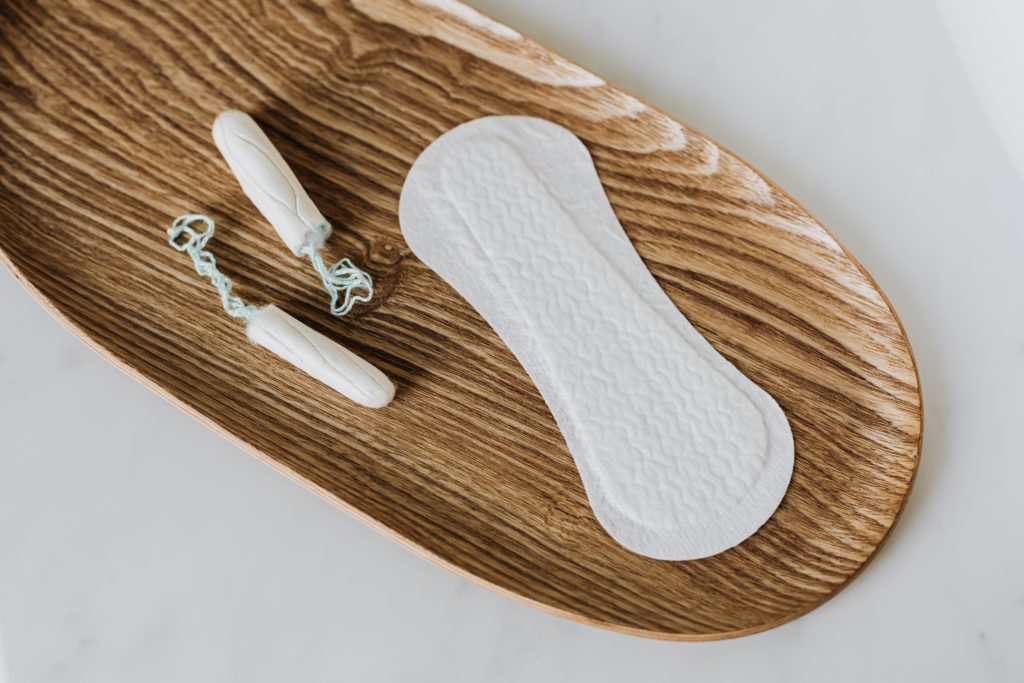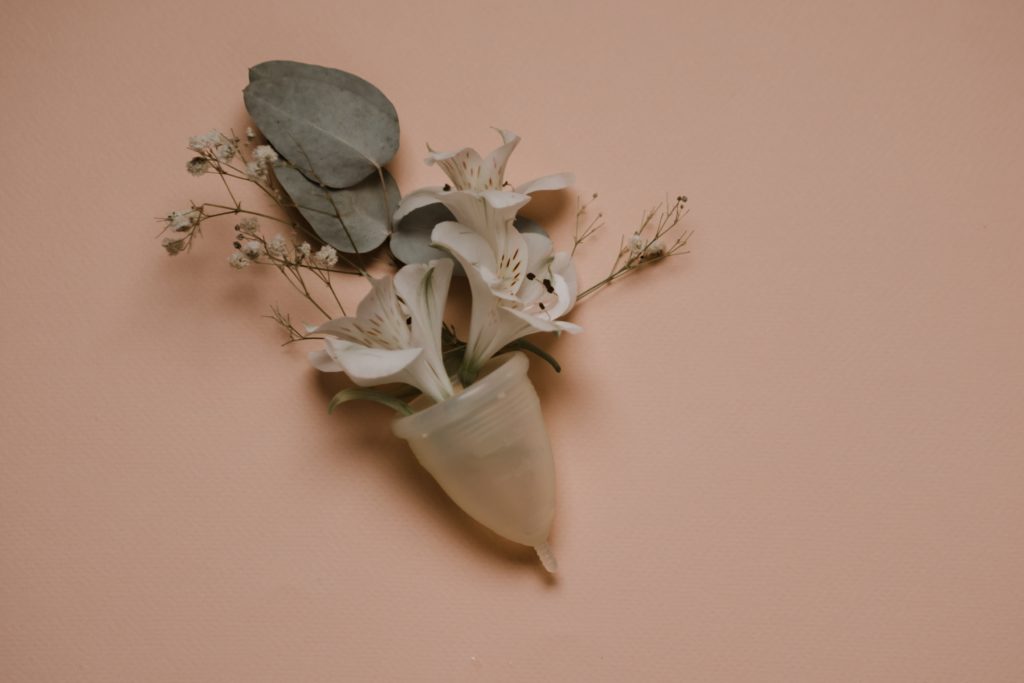Menstruation may be a fact of life but it doesn't need to harm the planet.
There is no single bigger issue we humans face than that of addressing the climate crisis that awaits us if we don’t radically change our lifestyles as a global collective. As Sir David Attenborough says in A Life on Our Planet:
“We need to rediscover how to be sustainable. To move from being apart from nature to becoming a part of nature once again.” In practice, this means re-evaluating the everyday decisions we make that contribute to polluting the environment including the products we use during our menstrual cycles. With this in mind, we’ve put together the ultimate guide to a sustainable period.
Conventional period products can take up to 500 years to degrade.
The Environmental Impact of Sanitary Products
As a species we produce about “300 million tonnes of plastic waste every year. That’s nearly equivalent to the weight of the entire human population.” (UN Environment, n.d.). Half of this waste is single-use plastic which includes menstrual products like pads and tampons.
Tampons come wrapped in plastic, typically contain polyethylene and polypropylene applicators and (you guessed it) even those little strings are made from plastic. Menstrual pads are said to include even more plastic due to their leak-proof designs, their synthetic fibres and the packaging they come in.

Menstrual products are defined as ‘medical waste’ in some countries, but not all , making it hard to grasp the full impact of their waste as it is not tracked (Friends of the Earth, 2018). Design aside, the way we dispose of our single-use period products has the biggest impact on the planet. The Marine Conservation Society estimates that some 1.5- 2 billion menstrual items are flushed down Britain’s toilets every year (Marine Conservation Society, 2015). Not only does flushing pads and tampons down the toilet create sewer blockages but huge swathes wash up on beaches with an average of nearly 5 pieces of sanitary waste found per 100 metres of beach cleaned. Conventional period products aren’t just a problem when they wind up in the ocean, they can take up to 500 years (yes you read that right) to degrade (Borunda, 2019)
On top of this - single-use period products are packed with chemicals such as absorbers, fillers, lubricants and pesticide residues from the bleaching of cotton and the manufacturing process. We know very little of their true nature of their composition as the industry regulates itself (Friends of the Earth, 2018). We do know that microplastics + chemicals and the environment are a toxic and unnecessary mix.
Those who menstruate will on average do so for 40 years, racking up an average 2,400 days of bleeding over the course of a lifetime which amounts to six and a half years and up to 200kg of menstrual product waste (London Assembly & Environment Committee, 2018).
Those are some staggering figures and it doesn’t need to be that way, which leads us to rethink how we have our periods. There must be a better way! And there is.
How Can I Make My Period More Sustainable?
We have been sold the myth that wrapping conventional menstrual products in plastic makes them more hygienic and safe for our use - this simply isn’t true. Especially when in countries like the UK, they are not categorised as ‘medical devices’ and are therefore not sterile (Friends of the Earth, 2018). Reusable period products have been around for a long time but still can’t compete with the huge marketing budgets of the conglomerates such as Tampax and Always that dominate the sanitary products industry. Thankfully, as we as a society become better educated on the environmental perils of single-use plastics, more of us are waking up to the beauty and comfort of sustainable period products such as:
Menstrual Cups

Menstrual cups are reusable funnel-shaped cups made from rubber or silicone that are inserted into the vagina to collect period fluid. They can hold more blood than other menstrual products available and depending on flow, can be worn for up to 12 hours. Disposal and cleaning is easy and they can even be (and should be) sterilised to maintain hygiene. There are different sizes to choose from depending on whether you have or haven’t given birth, as well as your individual average flow rate. Whilst they may have been on the expensive side a decade ago, the explosion of new models onto the market have driven down their cost and made them more accessible than ever before. This, along with the fact they save money in the not so long run, makes them an economical and sustainable method of period management.
Reusable Pads

Just like conventional pads, reusable ones can be secured to your underwear and absorb menstrual fluids. Unlike conventional menstrual towels or napkins, they have a washable holder and absorbent pad that is washed and reused. Reusable pads come in a variety of sizes to accommodate your flow and it’s advised to change them every four to eight hours or when wet or full. The used pad can then be thrown in with your usual laundry or washed thoroughly by hand with soap and hot water. To be truly sustainable, you will want to purchase reusable pads made from natural fibres, unbleached and packaged in cardboard rather than plastic.
Reusable Period Underwear
Period pants or reusable period underwear seems to be the most recent development in #plasticfreeperiods. Made from leak-proof and odour-eliminating fabrics, these absorb period blood directly and can like reusable pads, be washed over and over again. Many people report feeling more confident and comfortable as a result of switching to specially-designed period pants that are available in a variety of styles from thongs to boxers and even bikini bottoms and onesies! Whilst these products could be considered as a pricier way of getting through your period, they quickly pay for themselves per wear and should be considered as an investment whether you wear them throughout your cycle or just on your lighter days. They’re also great for sweaty workouts and sleeping!
Eco-Friendly Tampons and Pads

If you feel more comfortable sticking to tampons and pads then there are sustainable options available if you look. Opt for non-applicator tampons made from natural and unbleached fibres like bamboo or cellulose. If you prefer applicator tampons, you can consider investing in a reusable applicator or a brand that uses cardboard applicators for an easier insertion. Chiefly, try not to buy products which contain or are packaged in unnecessary plastic as this defeats the objective of being more environmentally-friendly.
The Sustainable Period Checklist
-
Research and choose the right sustainable period product for your needs.
You may find a combination of different eco-friendly menstruation products works best and helps you commit to reducing period waste. Some ideas and options are :
- Menstrual cups
- Period cloths
- Period underwear
2. Avoid unnecessary plastic wherever you can
From the product itself to the packaging it comes in - plastic is the problem. Opting for natural or eco-friendly alternatives wherever possible will help to reduce your personal carbon footprint. Things to consider :
- Tampons that do not use applicators, or at cardboard ones if newer to tampons
- Pads that do not come individually wrapped in plastic
3. Go organic!
Organic period products are much better for our bodies as they don’t contain pesticides or harmful chemicals. They’re also kinder to those producing them and use less water when produced. Organic sanitary products are biodegradable too, making them a winner all round when it comes to sustainability.
4. Don't flush!
Never ever flush sanitary products down the toilet! Instead consider composting biodegradable tampons and towels - they can take up to 18 months to break down but that’s far better than the half century or more that it can take single-use products to break down in landfill!
In most washrooms you will find a rubbish bin at your disposal for used menstrual products.
5. Tell your friends!
The more of us that make the switch to sustainable period products, the better off the environment will be. Contribute to the erasure of the period taboo and to protecting the planet by telling your friends all about your favourite sustainable menstruation products. Share this article to help your friends get a better idea how to have a more sustainable period.
We hope that our ultimate guide to a sustainable period has inspired you whether you’re new to eco-friendly period management methods or have been using them for a while. Together we can make this natural element of lives align with preserving and saving the natural world that affords us so much!

References
Borunda, A. (2019, September 6). How tampons and pads became so unsustainable. National Geographic. Retrieved December 05, 2020, from https://www.nationalgeographic.com/environment/2019/09/how-tampons-pads-became-unsustainable-story-of-plastic/
Friends of the Earth. (2018, October 15). Plastic Periods: menstrual products and plastic pollution. Friends of the Earth. Retrieved December 03, 2020, from https://friendsoftheearth.uk/sustainable-living/plastic-periods-menstrual-products-and-plastic-pollution
London Assembly & Environment Committee. (2018, August 14). Single-use plastics: Unflushables. London Gov. Retrieved December 05, 2020, from https://www.london.gov.uk/sites/default/files/plastics_unflushables_-_submited_evidence.pdf
Marine Conservation Society. (2015, April). Marine Plastics Pollution Policy and Position Statement. Marine Conservation Society. Retrieved December 05, 2020, from https://www.mcsuk.org/downloads/pollution/PPPS%20Marine%20Plastics.pdf
UN Environment. (n.d.). This World Environment Day, it’s time for a change. UN environment. Retrieved December 03, 2020, from https://www.unenvironment.org/interactive/beat-plastic-pollution/
Popular reads on YPC
How to Talk About Your Period With Men
Talking about periods with male friends and co-workers doesn’t have to feel like unleashing landmines.
Read moreWhy and When Did Menstruation Become Taboo?
From the Yukon to Greece, taboos around menstruation have been around for ages and still…
Read moreSocial Media’s Important Role in Reducing Period Stigma
From the explosion of period art, to serving as an activist platform in the menstrual…
Read more